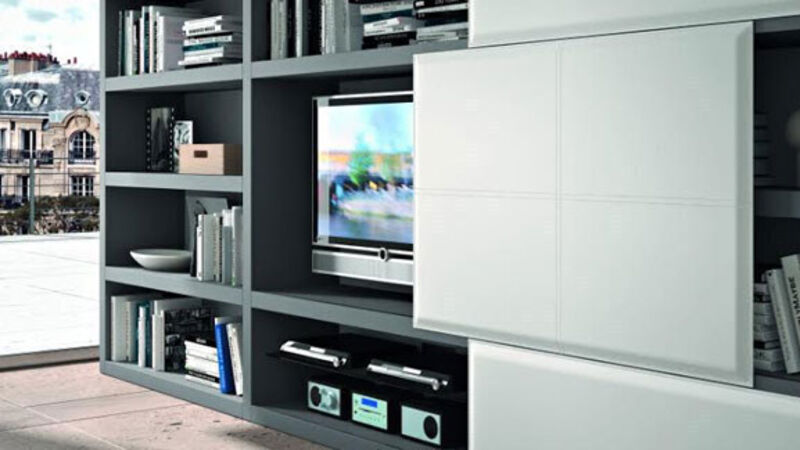Tune your TV space into something special

OUR lives might not actually revolve around rude electronics, but very often our interior landscaping most certainly does. With multiple viewing sites becoming commonplace, interrupting corridors and making furniture arrangements mere conduits between ceaseless viewing platforms.
I’ve shuffled sideways into rooms already spatially under assault from a two-seater couch, to find four children, two mounted on the chair arms, staring up at a 40’ flat-screen mounted a metre and a half from the floor.
Mouthing the ‘mwah’ of accepted greeting, faces uplifted from any danger of eye contact, a religious apparition swinging from the picture rail couldn’t hold greater sway. I’m actually all for the family TV. At a time where personal PCs, phones and tablets are splintering families from a tender age into separate rooms, sitting down as one to watch standard programming is likely to become tender nostalgic memory.
The modern flat-screen is a wonderful improvement on the metre deep box set out from a spaghetti junction of warm wiring that we all put up with for years.With wall mounting, there’s potential to really improve the TVs former intrusion when off, and more completely enjoy its expense and technological majesty when on.
The latest trend gleaned from the US is to put an enormous flat-screen over an existing fireplace with blackout blinds at the ready on strategically planned west-facing windows.It’s a bald statement that the television has conquered the former primal heart of the house- but there it is. Done badly, it’s aesthetically the equivalent of the front mounted double garage.
If you have gas or other cool faux light-show of a fire, it’s tempting to showcase the pulsating metre of HD as modern hovering artwork.
Some points: Don’t vie with the shape and status of the fireplace opening. If you’re building or renovating, install something like a slender vertical ‘letterbox’ reveal for the fire that will contrast with the more rectangular telly above.
Setting the TV at an angle on a stand or supported by built-in cabinetry to one side of the fireplace is a good compromise.If you have a long elegant opening and a useful breast you want to use, try off-setting the screen over one end rather than placing it at its centre. Think about hanging height. You should be looking at the centre of the screen when seated, something difficult to achieve when placing the box over the mantle.
Ensure you’re sitting well back from a larger set or angle it down (see our distance/TV size guide). A lower position is often not only more comfortable but on a stand or wall, looks more discreet in a living room. Television stands, mounting brackets and cabinets are under-used for their dynamic potential.
A lighter, slender screen can now move forward out into position when needed, be turned towards a seating area dedicated to non-electronic gatherings, and slide back out of sight when off duty.
Think about including the TV deliberately in an architectural column - great for kitchens where you want a small to medium panel present but safely out of splash range.
Framed walls can be cut out to recess a television flat to the wall (allowing for wiring, cooling and tilt) and masonry walls planned with a suitable niche when you’re improving.
For clean wireless chic, house players, digital boxes and other devices in a cabinet to the rear, with access on the side of the column in a vented door.
If the TV is up on the wall, you can lessen its presence by day by using a darker colour to make it recede. Without a colour framing, this could be anything from a chalkboard black to a deep colour or medium grey in a paper or paint. Another approach is to lose the screen in an arrangement of artwork, treating it boldly as one framed object in a group of prints, paintings or photographs.
With a media cabinet, follow the long, low lines of a sideboard placing the TV on top with blind cabinet doors below as storage for the attendant rubbish.
Alternatively, take a whole wall to task, setting the screen on a stand or wall mounted inside a void in a larger storage system. Frame it carefully in a dedicated box of space, and carefully arrange books, ornaments or whatever to compliment the screen and draw the eye away from it when it’s off.
Bookcases and larger box storage of this kind are ideal for hiding the scramble of wires that can ruin the look of an elegant flat-screen. Wind excess cabling onto something like a cable turtle (try Amazon for pieces from around €3.50).
Ensure the depth of any shelving with solid uprights does not block the view of the screen side-on, and that there is sufficient air-circulation for electrical components.
If you don’t want the reception room with the principle television to be regarded as the media room, there are further steps you can take to lessen the screen’s rank.
It makes sense to put a suite in a hug around the TV or course, but choose two armchairs to sit forward and left and right that swivel. This way you can centre a coffee table in the centre of the group and turn the sitters back towards the conversation, de-throning the screen in an instant.
If the screen has to be set higher than the ideal of eye level, choose low slung chairs with backs that tilt slightly back to raise the shoulders and face.
The resolution of a modern LCD or LED screen is searing. Sit too close and all you will see on an over-sized TV is what it termed ‘pixilation’ even in HD. Some televisions offer higher (1080p) resolution and you can sit closer to them for a more wrapped around experience without a loss of image quality.
However, most screens have an optimum viewing distance based on their technology and size (measured from one corner across the diagonal). This is basically in the following imperial/metric mix of screen size to viewing distance as TVs still follow inches.
32”: 1.3 metres
40”: 1.6 metres
42”: 1.8 metres
46-48”: 2 metres
50”: 2.1 metres
There have been a number of tragedies reported involving flat screen televisions falling both on adults and children even from a floor mounted stand.
When positioning any heavy electronics ensure you use only a wall mount dedicated to that model and ensure it is securely fastened to the wall or set on a suitable stand out of the reach of young children.











